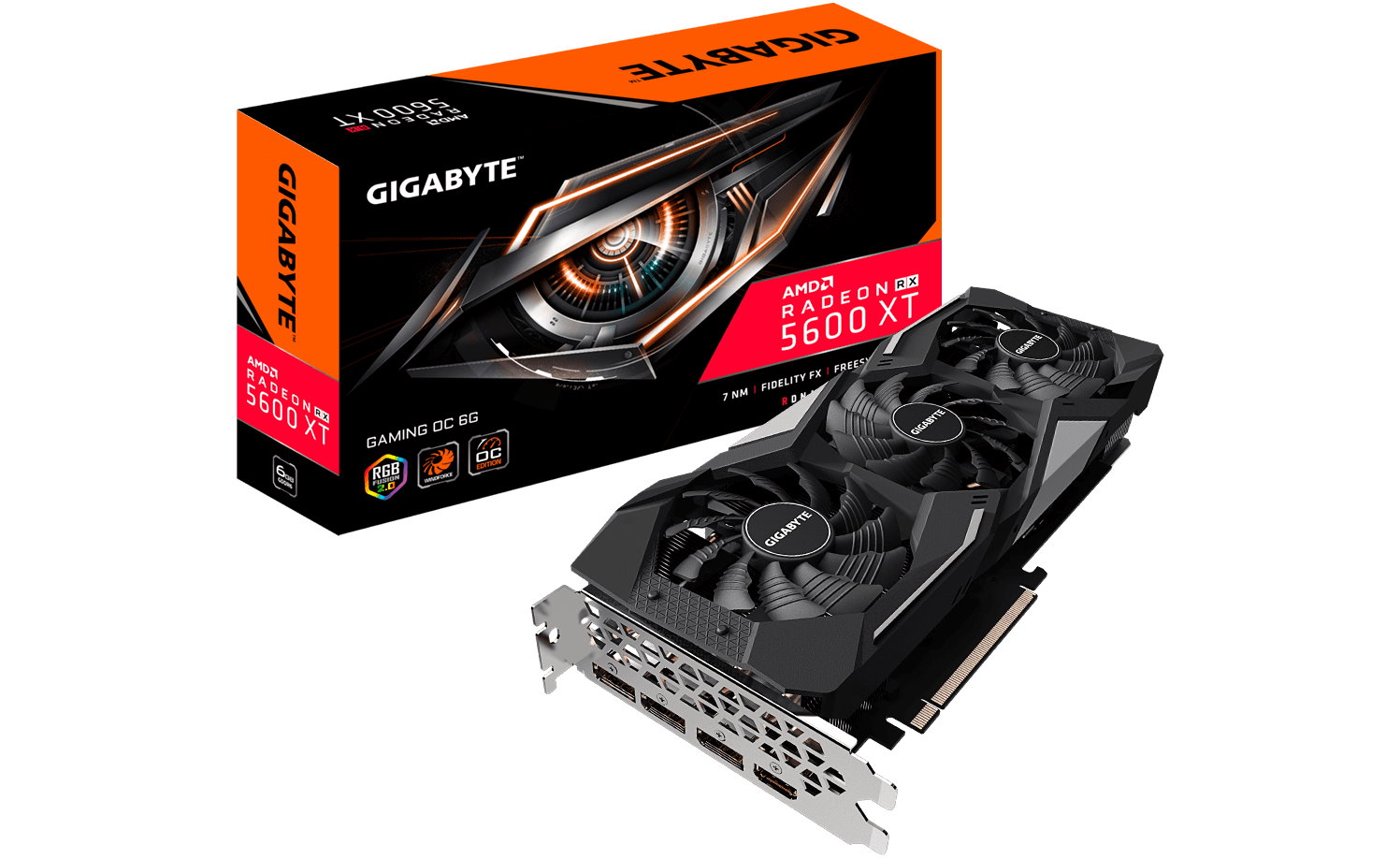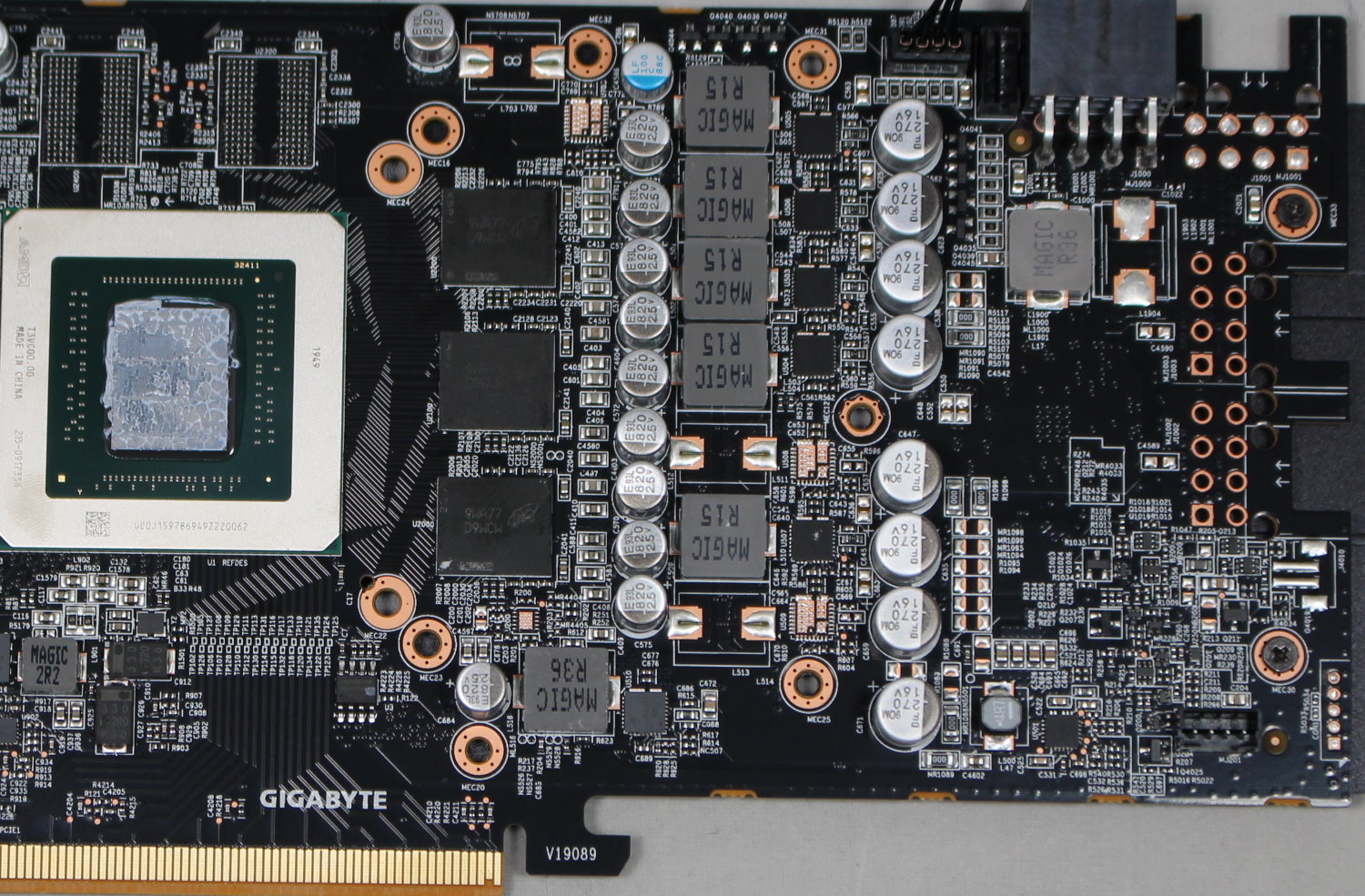Tom's Hardware Verdict
The Gigabyte RX 5600 XT Gaming OC 6G performed well, delivering over 60+ fps at 1080p using ultra settings, and it's capable of 1440p gaming with medium to high settings. This is a good card in the $300 price bracket.
Pros
- +
Great 1080p and good 1440p performance
- +
Quiet and capable cooling solution
- +
Priced well compared to other RX 5600 XTs
Cons
- -
11-inch length may not fit in some SFF cases
- -
Wild fan speed variations during Metro: Exodus testing
Why you can trust Tom's Hardware
The Gigabyte RX 5600 XT Gaming OC 6G is the company's flagship non-Aorus branded SKU. Gigabyte started with AMD's reference design, then increased both clock and memory speeds, with the Windforce 3 cooler keeping things frosty. Performance was just as good as the other RX 5600 XT cards we've tested, making this a good option in the $300 graphics card category.
Performance of the Gaming OC 6G was spot-on, trading wins with the Sapphire RX 5600 XT Pulse across our testing suite. Meanwhile, the Asus card we tested, with its slower memory, still brings up the rear and is the slowest of the 5600 XT bunch. However, the Asus manages to beat out the more expensive and power-hungry Founders Edition RTX 2060. Gigabyte's heatsink and cooling maintained good temperatures, with the card running quiet while doing so, making this a well-balanced video card.
At the time of writing, the Gigabyte RX 5600 XT Gaming OC 6G costs $299.99 on Newegg, placing it on the less expensive side compared to other RX 5600 XTs. The Sapphire RX 5600 XT Pulse is still the least expensive at $289.99, while the Asus ROG Strix 5600 XT O6G costs the most at $339.99. The Gigabyte and Sapphire cards, so far, have the price to performance ratio in their favor. Compared to the $319.99-plus ray tracing capable RTX 2060s, the Gigabyte card continues its price to performance reign. We'll take a closer look at how the Gigabyte RX 5600 XT Gaming OC 6G performed in our test suite and how the cooler fares compared to the other two RX 5600 XT's we've reviewed so far.
Features
Under the hood, the Gigabyte RX 5600 XT Gaming OC 6G uses the Navi 10 GPU—the same silicon found in the RX 5700 and RX 5700 XT. The die is manufactured using TSMC's 7nm finFET process, placing 10.3 billion transistors onto a 251 square mm space. The RX 5600 XT features 36 Compute Units (CUs) for a total of 2,304 stream processors with each RDNA based CU having four texture units totaling 144 TMUs and 64 ROPs.
The Gaming OC's core clock speeds are listed at 1,607 MHz Game clock and 1,750 MHz Boost clock. Compared to the reference clocks (1,375 MHz/1,560 MHz), this is a significant increase and brings noticeably higher performance versus stock clocks.
Just before the RX 5600 XT was released, AMD provided partners with an option to increase GPU clocks along with the effective memory clocks to 14 Gbps. Some card partners responded with a new BIOS to raise the clocks on existing cards, but this was done so late in the launch cycle that not all cards are validated for the higher speeds. Some SKUs still use 12 Gbps memory and others have been updated to reach 14 Gbps. Some vendors like MSI and Asus have created new SKUs that run with the faster memory speeds. Gigabyte chose to simply update the existing lineup, having faith in their printed circuit board (PCB) and memory ICs. In this case, the card comes with 14 Gbps memory so there are no worries here about stability.
AMD's RX 5600 XT cards all come with 6GB of GDDR6 memory riding on a 192-bit bus. Reference speeds are 12 Gbps, but the Gigabyte is set to 14 Gbps. The higher speed raises the bandwidth from 288 GBps to 336 GBps—a significant improvement that shows up in our testing.
Get Tom's Hardware's best news and in-depth reviews, straight to your inbox.
The reference specifications call for a power consumption of 150W, which is less than the RX 5700 (180W) and more than the RX 5500 XT (130W). Partner cards are free to deviate, and the Gigabyte card is rated at 180W and recommends at least a 450W power supply. A single 8-pin PCIe connector is required.
The following table summarizes the specifications of AMD GPUs and recent 5600 XT graphics cards that we've reviewed:
| Header Cell - Column 0 | Gigabyte RX 5600 XT Gaming OC 6G | Asus ROG Strix Radeon RX 5600 XT O6G Gaming | Sapphire Radeon RX 5600 XT Pulse OC | Radeon RX 5700 |
|---|---|---|---|---|
| Architecture (GPU) | RDNA (Navi 10) | RDNA (Navi 10) | RDNA (Navi 10) | RDNA (Navi 10) |
| ALUs/Stream Processors | 2304 | 2304 | 2304 | 2304 |
| Peak FP32 Compute (Based on Typical Boost) | 8064 GFLOPS | 8064 GFLOPS | 8064 GFLOPS | 7949 GFLOPS |
| Texture Units | 144 | 144 | 144 | 144 |
| ROPs | 64 | 64 | 64 | 64 |
| Nvidia Boost/AMD Game Rate | 1670 MHz | 1670 MHz | 1615 MHz | 1625 MHz |
| AMD Boost Rate | 1750 MHz | 1750 MHz | 1750 MHz | 1725 MHz |
| Memory Clock | 14 Gbps | 12 Gbps | 14 Gbps | 14 Gbps |
| Memory Capacity | 6GB GDDR6 | 6GB GDDR6 | 6GB GDDR6 | 8GB GDDR6 |
| Memory Bus | 192-bit | 192-bit | 192-bit | 256-bit |
| Memory Bandwidth | 336 GB/s | 288 GB/s | 336 GB/s | 448 GB/s |
| L2 Cache | 4MB | 4MB | 4MB | 4MB |
| TDP | 180W | 150W | 150W | 177W (measured) |
| Transistor Count | 10.3 billion | 10.3 billion | 10.3 billion | 10.3 billion |
| Die Size | 251 mm² | 251 mm² | 251 mm² | 251 mm² |
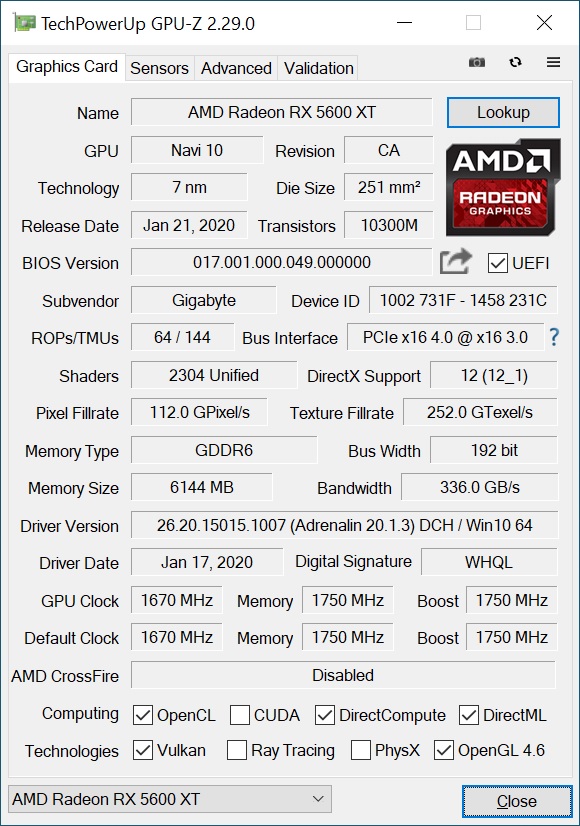
Design
The Gigabyte RX 5600 XT Gaming OC 6G is a factory tweaked, dual-slot full-size video card measuring 11 x 4.5 x 1.9-inches (279.8 x 114.3 x 49.5mm). Gigabyte's Windforce 3 cooler extends past the PCB lengthwise but is flush with the top and I/O plate. Given the length, this card may not fit in some small form factor (SFF) systems and some smaller mid-towers. Be sure to check the space inside your chassis before buying.
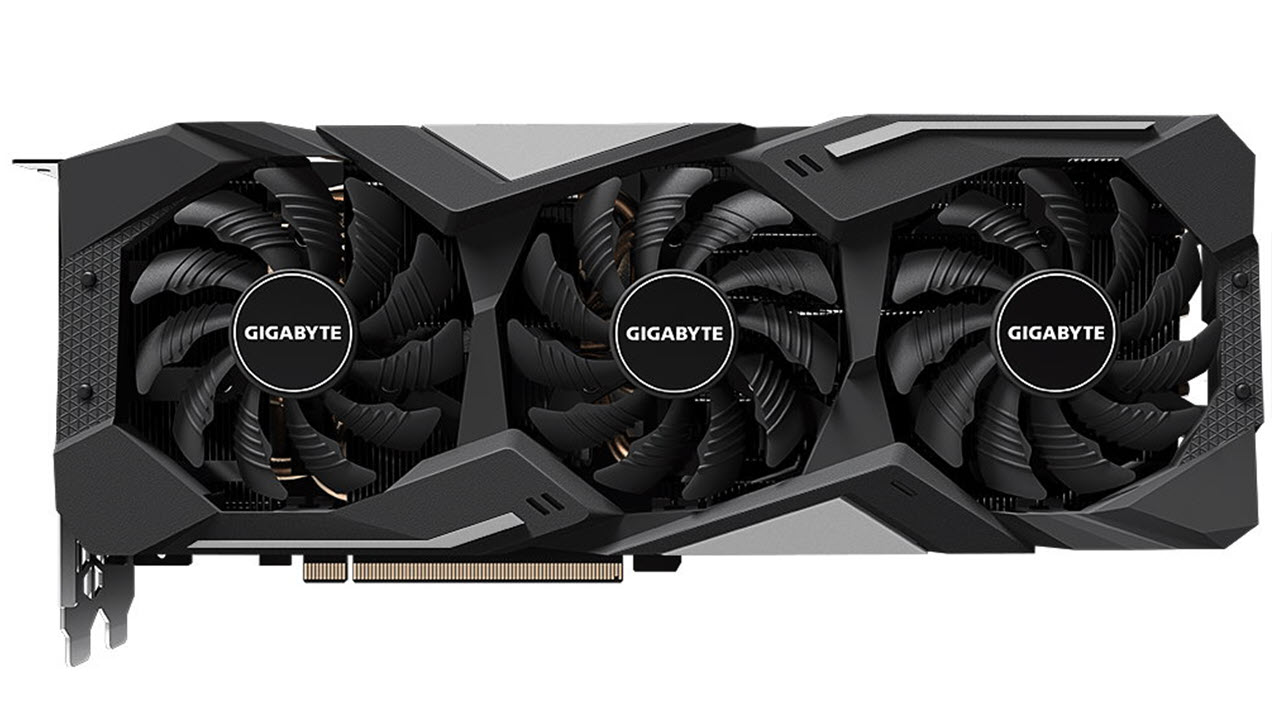

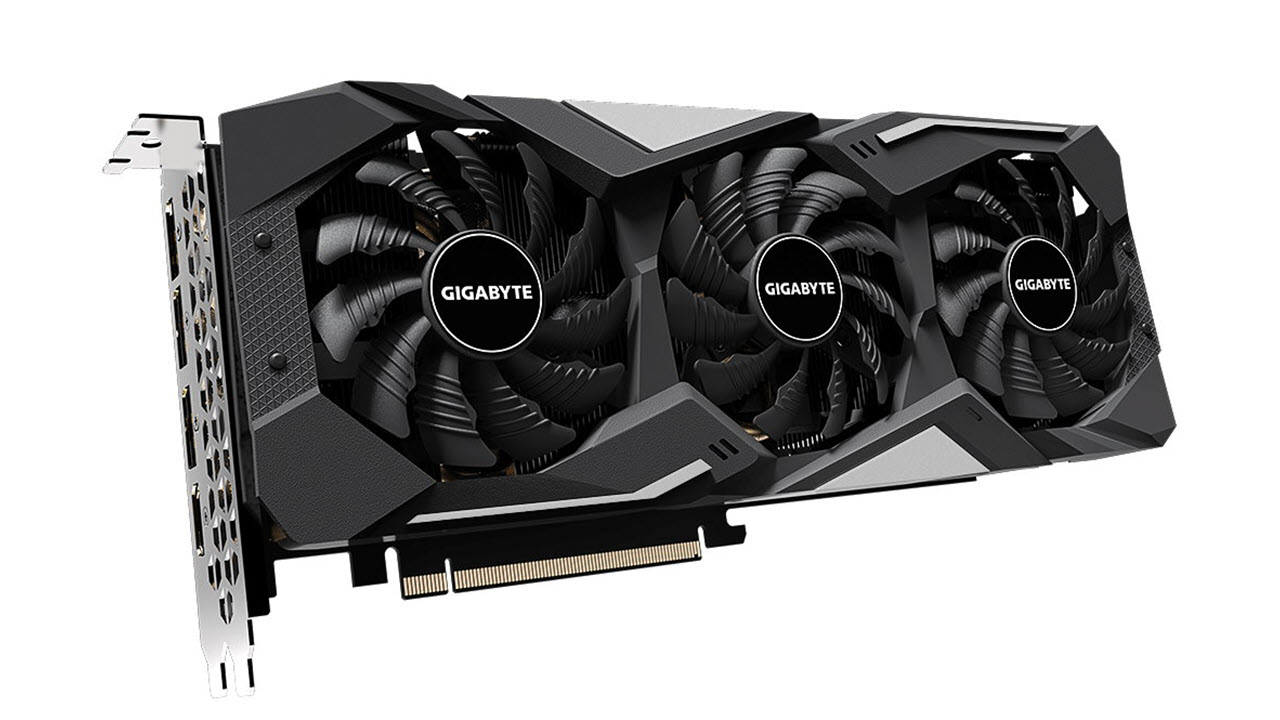
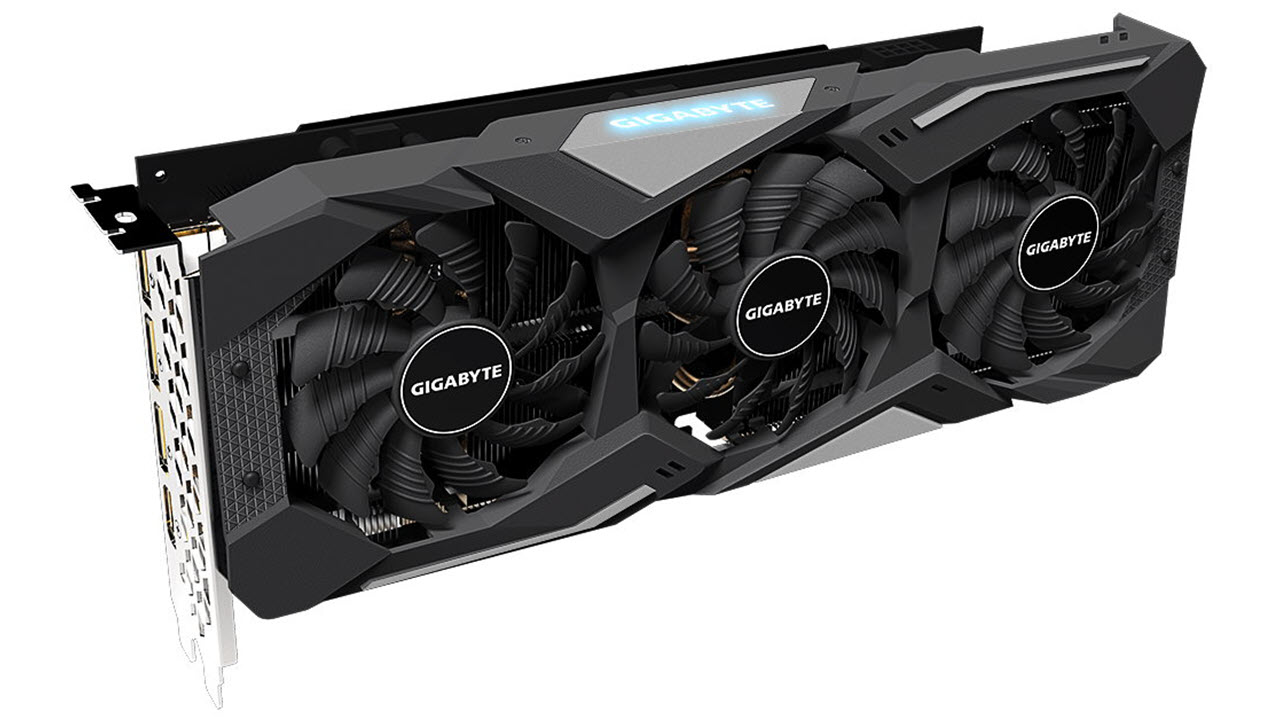

The Windforce 3 cooling solution uses three 80mm fans and is designed to cool all critical components including the GPU, VRAM, and MOSFETs. A predominately black shroud surrounds the three fans, protecting the PCB and heatsink underneath. Flanking the fans on the top and bottom of the shroud are grey accents. On top of the card, the Gigabyte name is lit up by the only RGB lighting on the card. The back of the PCB is protected by a metal backplate that serves as a passive heatsink while also enhancing rigidity.
The Windforce 3 cooler uses direct touch cooling where the six copper heatpipes directly touch the GPU die. Gigabyte says this configuration maximizes the direct contact area with the GPU for enhanced heat transfer. The heatpipes also cover the VRAM, though not by direct contact (there's a metal plate in between). The fin array is one large unit with the heatpipes snaking their way through it, removing heat from the critical components and into the fins.
Forcing air through the heatsink are three specially designed fans. The airflow is split by the fan edge and guided through slits on the blades, which Gigabyte says enhances the airflow. During low load or low power game situations, 3D Active Fan, which halts the fans completely. This makes the card completely silent in those situations. Gigabyte's Aorus versions have a small LED that lights up when the fan is off, but the less expensive Gaming version doesn't have this feature.
Power delivery is configured as 4+1 (GPU and Memory) controlled by an ONSemiconductor NCP81022 4+1 phase buck controller. Feeding power to the board is a single 8-pin PCIe connector. This configuration theoretically allows up to 225W of power, which is well over the 180W power limit, though not as much as the Asus or any card with additional PCIe connectors. Even with a single 8-pin connection, the card has plenty of power for stock and overclocked operation.
Outputs on the Gigabyte are standard fare consisting of three DisplayPorts (1.4) and a single HDMI (2.0b) output.
How We Tested the Gigabyte RX 5600 XT Gaming OC 6G
We've updated our graphics card test system to a new platform. The hardware consists of Intel's Core i9-9900K, an 8-core/16-thread CPU that routinely ranks as the fastest overall gaming CPU. The MSI MEG Z390 Ace motherboard holds down the fort, with 2x16GB Corsair Vengeance Pro RGB DDR4-3200 CL16 memory (CMK32GX4M2B3200C16). Keeping the CPU cool is a Corsair H150i Pro RGB AIO, along with a 120mm Sharkoon fan for general airflow across the test system. Storing our OS and gaming suite is a single 2TB Kingston KC2000 NVMe PCIe 3.0 x4 drive.
The motherboard is running BIOS version 7B12v16. Optimized defaults were used to set up the system. We then enabled the memory's XMP profile to get the memory running at the rated 3200 MHz CL16 specification. No other changes or performance enhancements were enabled. The latest version of Windows 10 (1909) is used and is fully updated as of February 2020.
Our GPU hierarchy provides a complete overview of graphics cards and how the various models stack up against each other. For these individual third-party card reviews, we include GPUs that compete with and are close in performance to the card that is being reviewed. On the AMD side, that consists of the Asus ROG Strix RX 5600 XT Gaming OC, a reference Radeon RX 5700, and the Sapphire RX 5600 XT Pulse OC. For Nvidia, we've included an EVGA GTX 1660 Super SC Ultra, EVGA GTX 1660 Ti XC, and an RTX 2060 Founders Edition for comparison.
Test System
| CPU | Intel Core i9-9900K |
|---|---|
| Motherboard | MSI MEG Z390 Ace |
| Memory | Corsair 2x16GB DDR4-3200 CL16 |
| Storage | Kingston KC2000 SSD 2TB |
| Power Supply | Corsair AX1200i |
| CPU Cooler | Corsair Hydro H150i Pro RGB |
| Fans | Sharkoon 120mm |
Our list of test games is currently Tom Clancy's The Division 2, Ghost Recon: Breakpoint, Borderlands 3, Gears of War 5, Strange Brigade, Shadow of the Tomb Raider, Far Cry 5, Metro: Exodus, Final Fantasy XIV: Shadowbringers, Forza Horizon 4 and Battlefield V. These titles represent a broad spectrum of genres and APIs, which gives us a good idea of the performance differences between the cards. We're using driver build 441.20 for the Nvidia cards and Adrenalin 2020 Edition 19.12.2 for AMD cards (the 5600 XT uses 20.1.2 beta drivers).
We capture our frames per second (fps) and frame time information by running OCAT during our benchmarks. In order to capture clock and fan speed, temperature, and power, GPUz's logging capabilities are used. We'll be resuming our use of the Powenetics-based system from previous reviews in the near future.
MORE: Best Graphics Cards
MORE: Desktop GPU Performance Hierarchy Table
MORE: All Graphics Content
Current page: Features and Specifications
Next Page Performance Results: 1920 x 1080 (Ultra)
Joe Shields is a staff writer at Tom’s Hardware. He reviews motherboards and PC components.
-
King_V Interesting that the fan speeds were higher than that of the Sapphire Pulse, yet the conclusion has "less apparent noise" relative to the Pulse.Reply
And, by the graphs, kept things several degrees cooler.
I think that this Gigabyte model might beat out the Pulse on which one I choose when I do the GPU upgrade for my son's computer. -
AlistairAB ReplyKing_V said:Interesting that the fan speeds were higher than that of the Sapphire Pulse, yet the conclusion has "less apparent noise" relative to the Pulse.
And, by the graphs, kept things several degrees cooler.
I think that this Gigabyte model might beat out the Pulse on which one I choose when I do the GPU upgrade for my son's computer.
Gigabyte can have wacky fan behaviour married to good fans. I usually just set a fixed rpm and call it a day with them, as their zero rpm mode can be bad. Same as Zotac. If you want good zero rpm modes, you have to buy MSI usually. -
g-unit1111 I got the XFX Thicc II 5600XT and I've been pretty pleased with it so far. It's good to see AMD upping their GPU game after losing to NVIDIA for so long.Reply -
Nick_C Reply
Can you please provide a link to that card for sale new at $150?IceQueen0607 said:How does this compare to the MSI GTX 1660 Ti Gaming X?
Given that the GTX 1660 Ti is $150 cheaper, for a small percentage performance improvement It's not really worth the buy?
(given that the 5600XT MSRP is $300) -
You misunderstood. I didn't say the GTX 1660 Ti was $150 new, I said it was $150 less than the RX 5600 XT. I'm in Australia, so prices are AUD.Reply
-
Nick_C Reply
Without stating that the $ being referred to is AUD, not USD, context was lacking - as the default meaning of $ on an international site is almost always USD.IceQueen0607 said:You misunderstood. I didn't say the GTX 1660 Ti was $150 new, I said it was $150 less than the RX 5600 XT. I'm in Australia, so prices are AUD. -
Wow! I actually didn't quote any prices, only saying that it was $150 LESS. The context was supposed to be that it was 25% less than the AMD card. Anyway, if the lack of an A in front of the $ is misleading, I'll stick with percentages.Reply
-
Like I said "Wow!"Reply
The question regardless of what the currency is "If the GTX 1660 Ti is cheaper, is the RX 5600 XT worth the purchase if the performance increase is in the low single digits? I haven't seen any comparisons for those two cards, and I don't trust userbenchmark for performance.
Disappointing that a question about whether or not a card is worth purchasing has come down to a chastening for a missing 'A' in the question :! -
Nick_C Reply
The "25% less" was completely absent from the post quoted - thanks for adding that important detail.IceQueen0607 said:Wow! I actually didn't quote any prices, only saying that it was $150 LESS. The context was supposed to be that it was 25% less than the AMD card. Anyway, if the lack of an A in front of the $ is misleading, I'll stick with percentages.
I'd also expect that new hardware attracts a vendor premium due to initial supply / demand levels. The 1660Ti is probably well down that curve by now whereas the 5600XT is a relatively new release and prices will be on the high side for a while. -
King_V Replyg-unit1111 said:I got the XFX Thicc II 5600XT and I've been pretty pleased with it so far. It's good to see AMD upping their GPU game after losing to NVIDIA for so long.
Wasn't the cooler (or shroud) on the Thicc II problematic for thermals? Or at least it was for the 5700 or 5700XT? I was given to understand that there was some redesign of it, and possibly an exchange program XFX offered... and also why they went to the Thicc III. Kinda going from memory here, though.
